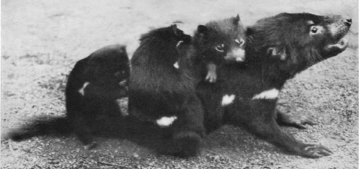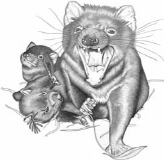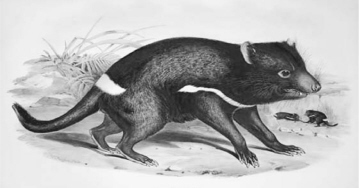Tasmanian Devil (11 page)

Devils regularly use communal latrines, as this area of scats clearly shows. The latrines
are believed to function like community noticeboards. (Courtesy Nick Mooney)
⢠Tripodâthe initiator raises one front paw off the ground while facing another animal, with the head held up and the tail down.
⢠Stiff leggedâthe initiator moves forward a short distance without flexing the joints of the legs.
⢠Urinatingâthe initiator urinates in full view of the recipient, sometimes in conjunction with stiff legs or gape. This action may also facilitate a chemical signal to the recipient.
⢠Ano-genital dragâthe animal presses its anus and genitals against the ground and drags itself along with its forepaws, while holding its chest off the ground. This posture is sometimes accompanied by gaping and an erect tail. It may also be associated with the transmission of chemical signals. Characteristic drag lines are often seen at communal latrine sites (and are easily mistaken for wallaby tail marks).
Devil literature sometimes refers to ano-genital dragging as cloacal dragging, but this term is inaccurate. Males as well as females engage in dragging, and they begin doing so well before being weaned. Although scent marking is associated with territoriality in many animal species, the function of dragging is not fully known.
Dens and home ranges are key aspects to understanding devil behaviour in the wild. Devils regularly use three or four dens, preferring wombat burrows, dense vegetation near creeks, thick grass tussocks, and caves where they are available. Old wombat burrows and caves are favoured maternity dens, no doubt because of their relative security from predators. Once established in dens adults tend to use them for life.

Devil pups cling to their mother when she needs to transport them. (Courtesy David
Fleay)
While adult devils alternate between dens, dependent denned young are not generally moved from one to another. Thus, while mothers with young have a fixed location, all other devils move around. It is apparent from this that the locality of dens forms an integral aspect of the spatial organisation of devils, as well as being critical to survival of the young. In this way the devil is more dependent on its den than its larder. The same applies to the wolverine, which also dens its young in a fixed locality. Studies have shown that habitat disruption, while it may not negatively affect the local food supply, exposes these natal dens and increases mortality as a result. When this occurs, the mother moves with the young clinging to her back; this greatly increases their vulnerability.
Habitat interference affects animals by altering the refuges where they breed, raise young and rest. For the devil this could be critical. Maternity dens are carefully selected to provide a safe haven from the elements and from scavengers. Young devils get cold easily and need the warmth of their nests and the sun. Favoured dens are strongly protected and may have existed for centuries. Destroying them through, for example, land clearance, disrupts population stability. Reduction in suitable denning habitat has significantly affected the wolverine.
The location and shape of home ranges appear to be controlled by the distribution of food, primarily wallabies and pademelons, both of which are present in large numbers in many parts of Tasmania. Both male and female adult devils are active between sunset and sunrise, travelling up to 16 kilometres a night in search of food. In this way they cover the extent of the home range, generally in a circular pattern. Males and females have similar sized home ranges, which is unusual in sexually dimorphic, solitary carnivores. Larger males obtain the additional food they need by eating for longer. While engaged on his doctoral research David Pemberton charted one devil's home range, which âtook in three hectares of the Musselroe Bay holiday village and tip site'.
6
In the 10 000 years in which they have lived isolated in Tasmania, the devil's predator competitorsâthylacine, wedge-tailed eagle, spotted-tailed quollâhave not threatened the survival of the species. Furthermore, apart from during the mating season and occasionally while feeding, devils do not engage in combat with one another. This is why, even though solitary, they are able to live together in high densities and share overlapping home ranges. Thirty devils weighing a combined 250 kilograms equates to many fewer bears or hyaenas occupying the same space. Even so, consider a Tasmanian farmer's anxiety if he had six hyaenas living in his back paddocks.

DEVILS AND EUROPEANS, 1803â1933
The devil stories I was told as a farm boy were shot through with menace. Devils were as dangerous as the name suggested. In large packs they stalked and harassed pregnant, sick or dying cows and horses. If the stricken animal refused to fall the pack leaders would bite clean through its front legs and the rest would swoop in . . . I can see now that the old men and women who said they knew for a fact that devils attacked animals many times their size were just trying to protect me from the dangers of the bush. But they were also voicing the fears they had inherited from those early convicts who were being literal when they named the carnivores they had newly encountered after the Prince of Darkness.
R
ODNEY
C
ROOME
, H
OBART
I
n 1803 an attempt to establish a convict colony at Port Phillip Bay (subsequently Melbourne) proved unsuccessful and led instead to the settlement of the penal colony of Van Diemen's Land. A member of the small founding group was George Prideaux Harris who, in Hobart Town, worked as a lawyer, journalist, surveyor and natural historian. He became the first European to describe and classify the devil, naming the squat, peculiar little animal
Didelphis ursina
. The name he gave the genus echoes the American opossum, while the species name was intended to reflect its bearlike (ursine) qualities, not least the small round ears. Harris correctly noted a number of similarities between the devil and the thylacine, one being a marsupial trademark, that the rear heels of both are long and callous.
George Prideaux Harris, after whom the devil is named, wrote the first description of the animal in 1806:
These animals were very common on our first settling at Hobart Town, and were particularly destructive to poultry, &c. They, however, furnished the convicts with a fresh meal, and the taste was said to be not unlike veal. As the settlement increased, and the ground became cleared, they were driven from their haunts near the town to the deeper recesses of forests yet explored. They are, however, easily procured by setting a trap in the most unfrequented parts of the woods, baited with raw flesh, all kinds of which they eat indiscriminately and voraciously; they also, it is probable, prey on dead fish, blubber, &c. as their tracks are frequently found on the sands of the sea shore.
    In a state of confinement, they appear to be untameably [sic] savage; biting severely, and uttering at the same time a low yelling growl. A male and female, which I kept for a couple of months chained together in an empty cask, were continually fighting; their quarrels began as soon as it was dark (as they slept all day), and continued throughout the night almost without intermission, accompanied with a kind of hollow barking, not unlike a dog, and sometimes a sudden kind of snorting, as if the breath was retained a considerable time, and then suddenly expelled. The female generally conquered. They frequently sat on their hind parts, and used their fore paws to convey food to their mouths. The muscles of their jaws were very strong, as they cracked the largest bones with ease asunder; and many of their actions, as well as their gait, strikingly resembled those of the bear . . . Its vulgar name is the Native Devil.
1

George Prideaux Harris, the deputy Surveyor General in the first party of Britons to
settle Van Diemen's Land, drew these devil and thylacine sketches for the Linnean
Society of London in 1806. (Courtesy Linnean Society of London)
Fifty years after Harris wrote his description of the devil, the English naturalist and artist John Gould compiled his three-volume
Mammals of Australia
and his seven-volume
Birds of
Australia
, both brilliant and enduring records. Gould, who predicted the thylacine's demise nearly a century before its extinction, wrote of the Tasmanian devil:
[I]ts black colouring and unsightly appearance obtained for it the trivial names of Devil and Native Devil. It has now become so scarce in all the cultivated districts, that it is rarely if ever, seen there in a state of nature; there are yet, however, large districts in Van Diemen's Land untrodden by man; and such localities, particularly the rocky gullies and vast forests on the western side of the island, afford it a secure retreat. During my visit to the continent of Australia I met with no evidence that the animal is to be found in any of its colonies, consequently Tasmania alone must be regarded as its native habitat.

Famous naturalist John Gould described many species of Australian fauna in the
mid-nineteenth century and had an array of artists working for him, including
Henry Richter who drew this devil from a live specimen in London's Zoological Society
menagerie. Unusually for a Gould work of art, it's anatomically incorrect, having a
small, underslung jaw. (Courtesy David Owen)
    In its disposition it is untameable and savage in the extreme, and is not only destructive to the smaller kangaroos and other native quadrupeds, but assails the sheep-folds and hen-roosts whenever an opportunity occurs for its entering upon its destructive errand.
    Although the animal has been well known for so many years, little or nothing more has been recorded respecting it than that which appeared in the ninth volume of the Linnean Society's Transaction from the pen of Mr Harris . . .2
Writing in 1880, author and artist Louisa Anne Meredith did much to publicise the new British colony. Her books were very popular in England and her chatty, hotchpotch style says as much about Victorian readers as it does the animal under scrutiny: